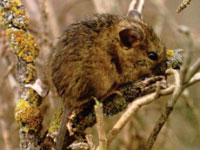Harvest mice
| Harvest mice | ||||||||||||
|---|---|---|---|---|---|---|---|---|---|---|---|---|

Harvest mouse ( Reithrodontomys raviventris ) |
||||||||||||
| Systematics | ||||||||||||
|
||||||||||||
| Scientific name | ||||||||||||
| Reithrodontomys | ||||||||||||
| Giglioli , 1874 |
The harvest mice ( Reithrodontomys ) are a species of rodent living in America from the group of the New World mice . They include around 20 species.
features
Harvest mice are very similar to the European actual mice ( Mus ), but they are not very closely related to them. They reach a head body length of 5 to 15 centimeters, the tail becomes 5 to 11 centimeters long. The weight is 6 to 20 grams. The color of their fur on the upper side varies from reddish brown to gray to blackish, the flanks are lighter and the belly white or light gray. The tail is thin and only sparsely haired, the ears are large and protrude from the fur.
distribution and habitat
The range of the harvest mice stretches from southern Canada over the USA and Mexico to Columbia and Ecuador . Most species inhabit grassy areas, but some can also be found in dry areas or rainforests.
Way of life
Harvest mice are nocturnal, during the day they rest in spherical nests made of grass and other plant material. These have a diameter of 15 to 18 centimeters and are built in bushes or small trees.
Their diet consists of seeds and saplings. You can get to the seeds of grass by bending the blades of grass to the ground and then gnawing out. Occasionally they also eat insects.
Reproduction
Except in cold winters, reproduction can occur all year round. After a gestation period of 21 to 24 days, the female gives birth to one to nine young animals. The females can give birth to offspring several times a year.
Harvest mice and humans
Harvest mice are generally not considered harmful to agriculture. Some species have even been able to expand their range by clearing the forests and spreading the grasslands, such as R. megalotis , which was also introduced to the Channel Islands .
In return, three species are considered threatened: R. raviventris , the only salt marsh near San Francisco inhabited R. rodriguezi that only a small area in Costa Rica is known and R. spectabilis , on the island of Cozumel before is endemic to the Mexican coast .
The species
A distinction is made between 20 species, which are sometimes divided into two sub-genera, Reithrodontomys and Aporodon . However, this classification is controversial.
- Reithrodontomys brevirostris occurs in Nicaragua and Costa Rica.
- Reithrodontomys burti lives in northwestern Mexico (Sinaloa and Sonora).
- Reithrodontomys chrysopsis lives in central Mexico.
- Reithrodontomys creper lives in Costa Rica and Panama.
- Reithrodontomys darienensis is only found in eastern Panama and possibly in neighboring regions of Colombia.
- Reithrodontomys fulvescens is distributed from the southern United States (from Arizona to Mississippi) to Nicaragua.
- Reithrodontomys gracilis occurs from the Mexican peninsula Yucatán to Costa Rica.
- Reithrodontomys hirsutus lives in a small area in western Mexico.
- Reithrodontomys humulis lives in the eastern United States (from Oklahoma to Florida and Maryland).
- Reithrodontomys megalotis is distributed from southwestern Canada over the western USA to southern Mexico.
- Reithrodontomys mexicanus is distributed from Mexico to Ecuador.
- Reithrodontomys microdon lives in isolated regions in Mexico and Guatemala.
- Reithrodontomys montanus lives in the Great Plains region in the central United States.
- Reithrodontomys paradoxus lives in Nicaragua and Costa Rica.
- Reithrodontomys raviventris is remarkable for its adaptation to the salt marsh habitat and can even drink salt water. The species only lives in a small area near San Francisco and is considered endangered.
- Reithrodontomys rodriguezi is only known from western Costa Rica. The species is considered endangered.
- Reithrodontomys spectabilis is endemic to the island of Cozumel off the Mexican coast and is considered critically endangered.
- Reithrodontomys sumichrasti lives in highlands from central Mexico to Panama.
- Reithrodontomys tenuirostris inhabits southern Mexico and Guatemala.
- Reithrodontomys zacatecae is native to western Mexico.
literature
- Ronald M. Nowak: Walker's Mammals of the World. 2 volumes. 6th edition. Johns Hopkins University Press, Baltimore MD et al. 1999, ISBN 0-8018-5789-9 .
- Don E. Wilson , DeeAnn M. Reeder (Eds.): Mammal Species of the World. A taxonomic and geographic Reference. 2 volumes. 3. Edition. Johns Hopkins University Press, Baltimore MD 2005, ISBN 0-8018-8221-4 .
Web links
- Endangerment level of the individual species in the IUCN Red List of Threatened Species .